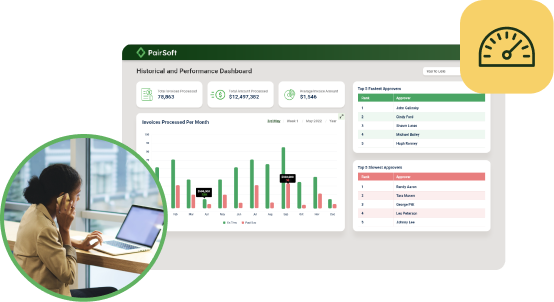Procure-to-Pay (P2P) automation is increasingly necessary in order to remain competitive in the current business environment. Automation also yields significant ancillary benefits, including cost savings, increased efficiency, and an increase in the bottom line. Implementation, though, can be a formidable task.
In order to achieve success with P2P automation, preparation and change management are key. Together, they can mean the difference between failure or success for the implementation. Executed well, preparation allows an organization to determine the optimum solution for its growth and efficiency goals and specific timeline. It also allows users to be on-boarded quickly and ensures strong adoption and usage rates, which are key to achieving a strong, ongoing ROI.
This guide will serve as a resource for organizations considering or preparing to adopt P2P automation software. It offers an outline of P2P change management, starting with a current market overview and an overview of quantitative and qualitative benefits, followed by a list of recommendations on the best practical approach for a few key stages of a technology transformation. Levvel Research’s goal with this guide is to increase the chances and success of a P2P transformation for optimization of the back office.
Market overview
Across North America, organizations are increasingly adopting automation solutions to address their accounts payable, procurement, and payments operations. The following section provides an overview and analysis of market trends using survey data collected from 2018 to 2019.
According to Levvel Research survey data, awareness of the value of cloud-based automation tools has increased in recent years, but there is room for growth in terms of adoption rates.
Cloud-based plug-in software has become increasingly flexible, dynamic, and affordable. Many options available today offer features tailored to the needs of different-sized organizations (e.g., a platform designed for the mid-market) and even industry-specific modules (e.g., an invoice data capture solution designed for the manufacturing industry). With capabilities such as real-time access to data, mobile applications, and supplier self-service portals, cloud-based solutions improve control, invoice, PO, and payment life cycle times, costs, and productivity.
For accounts payable, the size of an organization affects the type of solution it chooses to adopt (see Figure 1). Homegrown and ERP-based solutions are most popular among SMEs, but their popularity decreases and the preference for cloud-based solutions increases as organizations scale up. Cloud-based AP solutions are the most flexible, scalable options available today for organizations across revenue segments and business types.
Figure 1: AP Tool Type Based on Organization Size
“If your organization is using an AP automation tool, which type of tool do you use for the majority of your AP processes?”
(n = 134)
Similar adoption patterns occur for procurement automation solutions. Unlike AP, however, the most commonly adopted automation tool is a procurement module that is included in an ERP or in accounting software (see Figure 2). Instead of equally turning to cloud-based solutions, organizations are more likely to utilize a purchasing tool that is included with an existing system, even if it has fewer features or limited capabilities.
Accounting systems and ERPs that offer procurement modules are useful for multiple business functions, and organizations are likely to take advantage of these multipurpose platforms instead of adding another tool to their ecosystem. This is especially true for LMM1 companies, which prioritize maximizing tactical functionality within their current state rather than transforming their business operations, which can be draining on resources. ERP-based tools also minimize training necessary for employees who are already familiar with the system, and thus maximize user adoption.
Figure 2: Procurement Module is the Most Commonly Adopted Automation Tool
“Which automated procurement solution does your organization primarily use?” (n = 132)
1 Levvel Research defines organizations with revenue greater than $1 billion as enterprises, organizations with revenue between $501 million and $1 billion as upper middle market (UMM), organizations with revenue between $51 million and $500 million as lower middle market (LMM), and organizations with revenue between $1 million and $50 million as SMEs.
Payment method patterns are similar across company revenue sizes, although paper-based payment methods (i.e., checks) are slightly more likely to be used by smaller organizations (see Figure 3). Larger organizations are more likely to use an automated payment type, such as wire payments, which is likely due to these companies often having large and/or international supplier bases. Levvel Research hopes to see a decrease in the usage of manual payment types through the adoption of automated ePayments solutions, and the ratio of payment methods skew toward automated ones that are conducive to early discount capture, rebates, and security.
Figure 3: Payment Method Adoption Is Relatively Standard Across Company Size
“What percentage of your supplier-related payments (number of payments, not dollar value) is processed using the following methods?”
Barriers to adopting cloud-based automation solutions show similar trends across revenue segments. A shared top barrier for AP, procurement, and payables solutions is a lack of budget (see Figures 4-5); SMEs are more likely to cite this as a top barrier due to disproportionately smaller budgets than the rest of the market. Many organizations also believe that their current processes are adequate enough that they do not need to add software or automate; LMM companies are least likely to list this as a top barrier, as scaling into the UMM makes automation vital. Enterprise organizations are most likely to see executive sponsorship as an issue, due to the number of stakeholders involved and the complexity, scale, and resources associated with software adoption projects.
Figure 4:Lack of Budget is the Top Barrier to Adoption
“What do you perceive to be the greatest barriers to adopting a cloud-based AP automation solution in your organization?”
(n = 199)
Figure 5: Current Process Working Cited as Greatest Barrier to eProcurement Solution
“What is the main reason your organization does not currently use an automated procurement solution?” (Select one.)
(n = 207)
Benchmarks
Once organizations decide to move forward with an automation solution, they are likely to see efficiency gains correlative with their level of automation. Whether for AP, procurement, or payments, automation tends to yield improvements such as reduced paper volume, shorter cycle times, greater efficiency, and more transparency, control, and security (see Figures 6-7).
Figure 6: Department Productivity Cited as the Greatest Improvement from an eProcurement Solution
“How has each of the following improved with your organization’s automated procurement solution vs prior manual procurement processes? (Selected “Great Improvement”) (n = 132)”
Figure 7: Reduction in Paper, Quicker Approval Times, and Increased Visibility Are the Top Benefits of Automation
“What are the greatest improvements you have seen since implementing an AP management solution? (Select 3)
(n = 134)”
Organizations that have embarked on their automation journeys for AP, procurement, and/or payments see not only the qualitative benefits described above but also quantifiable savings. Levvel Research has separated companies into three categories—Novice, Mainstream, and Innovator—based on their level of automation, and has used these designations to analyze hard cost savings and ROI metrics of automation usage.
Table 1 shows how an organization’s cost per invoice decreases with increased automation. The more automation an organization has, the lower the average processing time and the higher the percentage of electronic invoice receipts they report, leading to lower invoice processing costs and higher rates of discount capture.
By automating purchasing processes, organizations utilizing procurement automation are able to process more purchase orders per procurement employee. Using a cloud-based eProcurement tool can bring down the cost per PO by 65 percent (see Table 2).
Payment automation allows an organization to capture more early payment discounts and rebates on current invoice payments. Automating payments also reduces costs in terms of supplies (e.g., printing and mailing materials) and employee labor. Freed from the burden of printing and mailing checks, AP staff can dedicate more time to strategic tasks. Cloud-based payments products can increase efficiencies by integrating simply with existing systems, and their intuitive user interfaces can enable quick implementation and staff onboarding. The relatively quick implementation and efficiency gains of payment automation allow organizations to keep pace in today’s competitive business landscape.
Technology transformation
When organizations are considering a transformation of their P2P state, it is vital that they approach their initiative with a thorough change management plan. Automating P2P processes does not have a one-size-fits-all solution, and it may be done incrementally while keeping open the possibility to scale up as needs and/or budgets change. There are a few key stages that typically occur during a technology transformation; the following section provides recommendations on how to approach each stage in order to increase the chances and degree of success for the transformation.
Current state evaluation
Prior to automation, organizations should map out their current state and comprehensive process metrics, including all current technology, AP users, departments, stakeholders, processing times, labor costs, and error rates. Companies should account for current process workflows and any other variables and details that make the organization’s P2P mechanisms unique. Decision-makers should assess information such as the number of ERP systems in place, monthly invoice/PO/payment volume, the number and type of locations where processes take place, and the number of touches (people involved) in existing invoice, purchasing, and payment workflows.
This current state map will improve the configuration stage of implementation, and organizations will be better prepared to identify a solution appropriate to their growth and efficiency goals. They can leverage this data when working with a solution provider to configure and customize a new AP solution to meet all their specifications.
Proper examination of their existing structure gives organizations vital context for comparing possible solutions and sets a solid foundation for future implementations and process changes. With this information, they can use ROI calculators (for pre- and post-automation states), as well as create and track KPIs. When defining goals and planning for transformation, teams should strive to be as clear and precise as possible about how to adopt a solution and its ultimate payoff for the organization. A collective vision should be organized into discrete, well-defined benefits, with each goal being approached with a strategic plan. Those implementing the solution should ensure they value all voices within a company, including all AP, procurement, and finance department staff and managers.
Practitioners should also determine how automation technology will affect future staff additions, task allocations, and potential augmentation. As an organization scales, it is crucial to stay ahead of P2P processes’ needs, rather than addressing pain points after they emerge. Change management teams should incorporate future technology into their organizations’ roadmaps.
Assessing the current AP state prior to technology adoption can go a long way toward determining and pitching the ROI and business case to key decision-makers. With proper preparation and scoping prior to implementation, organizations of all sizes will be ready to successfully begin automating their P2P state.
Building a business case
Practitioners pushing for any AP, procurement, or payment automation solution must gain executives’ enthusiasm and support. They should build a thorough and well-researched business case to present to relevant decision-makers and C-suite personnel.
A business case should include a current state assessment, estimated savings, ROI metrics, and projected improvements, especially highlighting how an integrated solution would benefit executives directly. An example of a significant benefit is increased visibility into spend data that the C-suite—especially a CFO— will harness with advanced reporting and analytics tools, which will, in turn, enable them to make more strategic business decisions. Ultimately, aligning the benefits of automation with the company’s business plan will lead to greater buy-in and enthusiasm for technology adoption.
Process optimization
Applying technology to a broken process is a “band-aid”, not a cure. Organizations should understand that technology is meant to enable improvement, but in order to actually create that improvement, inefficiencies in processes must be evaluated, understood, and optimized as much as possible. Current state optimization should always take place before a solution is purchased.
Prior to technology adoption, departments can assess where bottlenecks typically occur in the current state so as to limit the possibility of these continuing to disrupt processes after automation. Departments can review and potentially restructure things like approval workflows, supplier inquiry management, staff allocation, or invoice storage methods to make sure the current state is set up in a way that minimizes wasted time or low-value activity. Strengthening the current state by identifying and correcting dysfunction is also a good way to boost enthusiasm from staff for the solution, as they see how their day-to-day functions have and will continue to improve; this in turn increases the chance of high user adoption of the solution, which increases ROI from the solution.
While organizations should typically address internal processes and teams first, they should not overlook external parties. For example, right before implementing a procurement solution is a perfect time to reevaluate supplier contracts, cleanse supplier data files, and perform other functions that reveal savings and more strategic supplier management opportunities. This is also a good opportunity to reach out to suppliers and prepare them for the coming changes, and ask for feedback on how interaction and processes could be improved for them.
Another valuable action to take prior to software adoption is to establish KPIs for AP and procurement processes. By identifying these in the current state, companies can more easily visualize improvements, and pinpoint problem areas, after implementation. Tracking KPIs is also a very useful way to measure the ROI from technology adoption.
Software selection
While P2P automation offerings were limited in capabilities and scope just a few years ago, there are many industry- and size-tailored options on the market today. These solution providers are often well positioned to help their customers scale their AP, procurement, or finance departments without losing efficiency or visibility. With an overwhelming number of options available today, though, it is critical that organizations critically evaluate their options.
Organizations should first decide which aspect of their P2P processes they are trying to automate: accounts payable, procurement, payments, or some combination of the three. There are many solutions available on the market today that focus on a specific process, and there are also those that provide a holistic suite with capabilities in all three functions.
Organizations should then identify solution providers that understand the needs of their size, industry, and even existing technical environment (e.g., ERP, supplier communication portals, payment partners, etc.). They should consider all of a provider’s features, helping decision-makers better identify which providers’ strengths best meet their organization’s needs.
The selected provider should be flexible so that the solution can adapt and change as the organization continues to scale. The solution provider should know the organization’s market, both in terms of revenue size and industry. There may be aspects of P2P automation that the organization has not considered because it is still relatively small, but a knowledgeable player in the space would be not only a resource from which to learn but also able to equip the organization with the best tools it needs as it expands.
Technology integration
With any software implementation, there will be IT architecting necessary, even if coming from a completely manual process. Organizations face a variety of considerations, and it is important to map out requirements and expectations during the solution selection phase. Bringing the IT team in early during selection will also improve the chances of gaining buy-in from a team that is typically reluctant to embrace disruptive new technology with which they are unfamiliar. IT’s support and interest in the software streamlines implementation and onboarding and improves utilization in the long run.
One of the most important aspects of technology adoption integration. ERP integration is particularly important for AP and procurement software, as is integration with many other existing business process solutions, such as a supplier information management tool, or homegrown solutions that internal teams maintain. Ensuring that systems can and will be properly connected is important for achieving ROI on the new and existing solutions alike.
Some providers offer API-agnostic tools, proffering the ability to connect seamlessly with any ERP, tool, or platform. The actual execution and seamlessness of these connections may vary. In the case of the ERP, agnostic integration capabilities could simply mean the solution supports batch uploads of data between the ERP and the tool, rather than offering a real-time connection. Some providers offer integration specifically built for a single ERP or product line of ERPs, which potentially offers a more seamless experience.
Many P2P providers also have several out-of-the-box (OOTB) integrations for solutions beyond ERPs via partnerships. In some cases, this might go beyond simply a custom integration between two separate systems; it might mean the providers offer an “app ecosystem” that allows the organization to opt-in to certain applications while remaining within the P2P system.
While these OOTB integrations are valuable to certain companies, some solution providers will work with potential and existing customers to build out tailored integrations if they do not offer them already. Finding a provider that is willing to have conversations around custom integrations and development is an important consideration for companies with many systems already in place or those with systems they are trying to replace or phase out.
Replacing existing processes and systems is a large driver of technology adoption. Some organizations are trying to move from on-premise tools to cloud-based infrastructure; others purchased a similar P2P solution a few years ago but did not have a successful adoption. To that end, an organization should ascertain how much support the existing solution provider can offer for things such as replacing systems, migrating data, and working with other project teams that may be undergoing digital transformation initiatives in other areas of the organization (e.g., cloud migration, DevOps implementation). Technology transformation service offerings vary by providers, but most provide implementation services and support through partners if not in-house.
Ensuring long-term value
In order to actually gain approval and funding and adopt a solution, members within an organization have likely spent significant time assessing the ROI of the technology. However, that ROI largely depends on the measures an organization takes after the solution is implemented and live. An organization should implement internal controls and practices for continued and improved use of the solution.
One way to ensure the long-term value of a solution is to take advantage of its measurement tools. Many solutions offer reporting/monitoring tools and analytics to gauge improvement and savings and to identify KPIs. Some also show usage of the tool by user, role, or department, and help determine whether the tool is being used to its full advantage across the company.
As previously stated, many providers will customize their solutions if their clients request it. Organizations should consider an innovative provider that will work with them to configure the product to the unique preferences of the organizations. It may also benefit some companies to choose a provider that offers modular solutions in case they are not sure how much of the tool they will use; the option to turn on and off modules could be to their advantage.
It is also important to work with a provider that encourages client input. Many offer forums or submission tools to allow customers to comment on specific functionality, report glitches, and submit requests for improvement. Some providers send out regular surveys to assess customer satisfaction, and some host regular customer roundtables to dive deeper into various issues or gaps in how their solutions work for their clients. A provider should not be afraid of or resistant to feedback from clients but should embrace it so as to continually improve their tool. Organizations should take advantage of any forums available to submit feedback, as this will improve their interaction with and ROI from the tool.
Finally, continue to innovate. Change management does not end when an AP or procurement solution is live, nor has an organization reached peak efficiency and optimization just because they have automated their back office. There is always further to go with technology and business improvement. Innovators should continue to seek out new ideas on how to improve, strategize, and transform their departments to the long-term advantage of their company. Information on how to do so can be found from analyst firms, business and tech journals, and peers.
Conclusion
Change management is vital when adopting a P2P solution, as it maximizes pre-implementation buy-in, improves the configuration stage of implementation, ensures solid integration with existing systems, and increases post-implementation user uptake. Organizations will be able to not only eliminate current AP and procurement pain points but also plan and prepare to tackle future pain points before they occur.
P2P software providers want their clients to get the most out of their solutions, so providers often offer a variety of change management services before, during, and after implementation. The following profile gives an overview of a P2P software provider that works with its customers to prepare for and optimize software adoption.
About PairSoft
PairSoft develops, sells, and supports advanced web-based and mobile requisition, procurement, accounts payable, and expense solutions for mid-market and enterprise organizations across a range of industries worldwide. PairSoft Payments provides enterprise users with the option of adding automated ACH payments within the PairSoft Spend Management solution for a fully centralized standalone P2P platform. The user interface offers flexible P2P automation and robust expense reporting that is easy for employees, effective for management, and powerful for accounting.
Solution overview
The PairSoft software solution can be deployed in SaaS/cloud-based and on-premise environments. It is offered as a standalone solution as well as a certified out-of-the-box seamless integration to leading ERPs including Microsoft Dynamics (GP, NAV, SL, AX, Dynamics 365 Business Central), Sage ERP (100, 300, 500), Sage Intacct, Blackbaud Financial Edge NXT, Acumatica, Acumatica Construction, SAP, and Oracle-NetSuite via ERP-specific APIs.
PairSoft also offers tailored integrations for other ERPs and industry-specific solutions using its Data Integration API toolset. The solution features multi-company, multi-language, and multi-currency support, as well as global taxation options (including HST, VAT, and GST). For system security, the solution leverages roles-based controls and several industry-driven authentication protocols including single sign-on, LDAP, active directory, OAuth2, and two-factor authentication.
PairSoft offers an intuitive user interface for both its desktop and mobile app solutions. The modern design allows companies to onboard users quickly and ensures strong user adoption rates. The PairSoft native mobile app provides purchasing, full requisition entry, and approval functionality from a user’s mobile app. Users can browse and shop company catalogs, request items for purchase, save items to cart, and submit items, as well as review, approve, and reject requisitions, add attachments, and add comments.
Procure-to-Pay
The PairSoft requisition solution can be configured to different types of users, roles, departments, and vendor marketplaces. The internal PairSoft catalog system and punch-out capabilities allow requestors to search for goods and services through a catalog-style shopping experience, as well as through a traditional transaction-style interface.
The solution supports centralized purchasing across multiple locations, allowing users to request, enter, and process transactions under the same controls companywide. PairSoft offers cost controls that integrate with and help enforce organizations’ budgets, vendor contracts, and project rules, as well as an automated three-tier tax engine for effective financial integration and reporting. Line-level multi-company and inter-company capabilities provide a single centralized procurement portal for larger organizations to integrate with multiple entities in their ERP.
Purchasing approvers can approve requests within the application, on their mobile app, or directly from notification emails. The solution’s parallel, line-level approval engine offers approvers unlimited approval levels and approval paths. Built-in collaboration tools include email notifications, web form questionnaires, delegation, automated escalation rules, ad hoc approval routing, and logged communication notes throughout the approval workflow.
Depending on an organization’s preferences, POs can be automatically generated and issued to vendors upon approval or reviewed and consolidated by central purchasing teams. PairSoft also includes full PO and change order management. Document retention, revision number tracking, quantity status, and a detailed audit log are available for every PO line and for users involved throughout the purchasing life cycle.
PairSoft offers multiple user-tailored receiving options, including filtered desktop receiving, one-click PO receipt, and detailed transaction entry. Users can be automatically notified when their requests have been fulfilled, unmatched invoices have been received, or expected orders have not been received by the specified delivery date. Upon receipt of an order, the solution supports both 2- and 3-way matching with automatic purchasing accruals that can be integrated at the GL level.
PairSoft offers AI, machine learning, and optical character recognition(OCR). Invoices are entered into the solution through the supplier portal by either scanning the invoice via OCR or by manually entering the information. PairSoft ’s Smart Invoice Capture tool incorporates rich machine learning functionality capable of recognizing patterns of user behavior and recommending data inputs, reducing the time users spend on keying and correcting data.
Scanned invoices can be automatically or manually matched to a PO. PairSoft ’s solution offers 2- and 3-way matching for loading one or more PO lines from one or more POs. The supplier portal supports PO and non-PO invoicing. PairSoft uses advanced OCR capabilities to improve PO invoice matching success rates. This reduces the required time spent processing transactions and troubleshooting data entry reduces financial reporting errors and allows procurement and payables staff to spend more time on strategic initiatives and critical thinking.
The approval workflow tool can handle any approval structure and organizational hierarchy. Configurable approval workflows support header, line, PO, and non-PO rules-based routing with unlimited approvals and approval path capabilities. Unmatched invoices are automatically sent through an exception workflow based on custom invoice variances, such as quantity or amount thresholds. The solution also offers escalations and reminders, out-of-office forwarding, and workload balancing for invoice approvals. Invoice approvers can approve or reject invoices from their mobile devices either directly from the notification email or through the mobile app (only for non-PO invoices).
After approval, the solution posts approved transactions to the general ledger. Once payment has been processed, remittance information is automatically transmitted to the respective suppliers, and payment information is updated and available for internal stakeholders to view from the originating transactions.
For payment, the PairSoft solution integrates with corporate cards that support Open Financial Exchange (OFX) communications. The solution also offers configurable file import mapping capabilities to accommodate client-specific banking requirements. A credit card interface is available to users at no additional charge.
Suppliers and vendors have access to a free self-service vendor portal with automatic PO notifications and the ability to submit PO, non-PO, and service invoices. They can upload invoices and attachments from the portal and are automatically notified by email when POs are available to view and match. They can also manage their own contact information; additions and updates are automatically fed to the PairSoft approval workflow for review. The system automatically syncs approved changes with the client’s associated ERP. PairSoft Supplier Network currently has over 850 suppliers registered. Companies can engage with new suppliers from the network or invite their own to register and participate in the network.
PairSoft is focused on empowering CPOs and CFOs to analyze financial data strategically with a 360-degree view of their KPIs in one dashboard. To enable this, PairSoft offers reporting tools and data analysis tools from a single dashboard that allows users to manage, evaluate, improve, and optimize many areas of their business. Users have the freedom to define their own metrics, customize the view, select from over 20 standard charts, create unlimited personalized charts, drill deeper into the data, and export the data for use in other applications. Out of the box, the PairSoft solution includes over 70 printed reports, dashboard charts, and metrics that cover all P2P modules.
Implementation and pricing
Implementation of PairSoft varies depending on the organization’s size and the licensed solution. The typical go-live duration is 60-90 days. PairSoft and authorized resellers offer one-to-one comprehensive training and department-wide training, as well as training workshops and on-demand custom training. Customers receive unlimited support, including free technical support via toll-free phone, email, or chat, and access to an online customer center with learning materials.
Pricing structures include a perpetual annual license or monthly SaaS payments.
Methodology
The findings presented in this report are based on online surveys conducted by Levvel Research in February and April 2019 among more than 250 finance and accounting decision-makers and influencers, as well as more than 350 procurement decision-makers and influencers in organizations with at least$1M in total revenue across all industries. Respondents were screened for their familiarity with their organization’s accounts payable, invoice receipt, and invoice routing processes. The data was weighted to represent the proportions of SME, mid-market, and enterprise organizations in Levvel Research’s database. This distribution is shown below.
Figure 10: Organization Size Distribution
About PairSoft
PairSoft develops, sells, and supports advanced web-based and mobile requisition, procurement, accounts payable, and expense solutions for mid-market and enterprise organizations across a range of industries worldwide. PairSoft Payments provides enterprise users with the option of adding automated ACH payments within the PairSoft Spend Management solution for a fully centralized standalone P2P platform. The user interface offers flexible P2P automation and robust expense reporting that is easy for employees, effective for management, and powerful for accounting.







